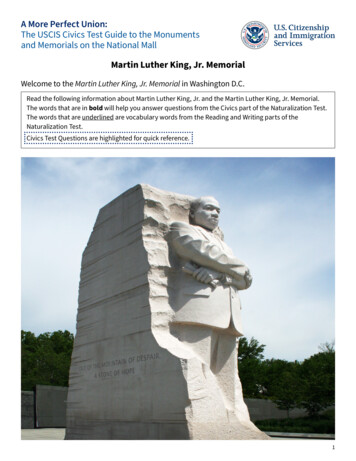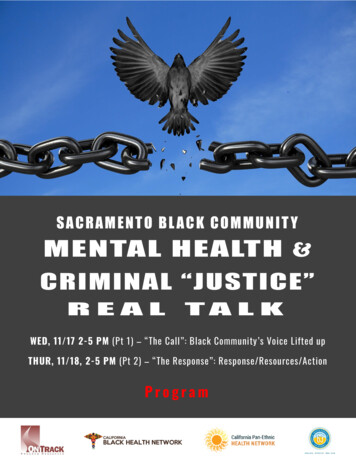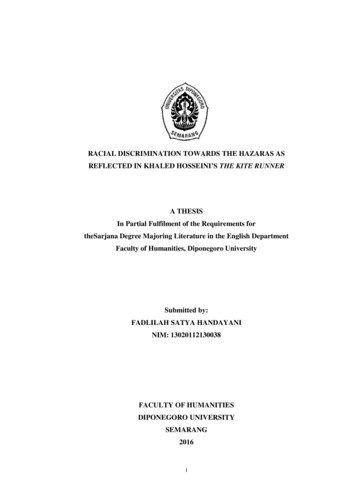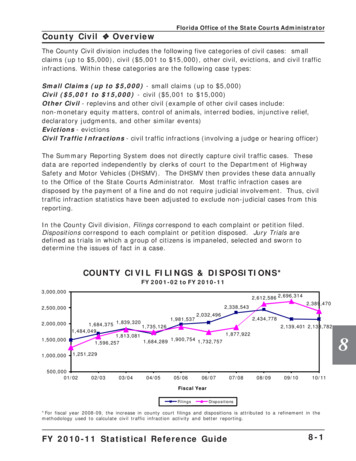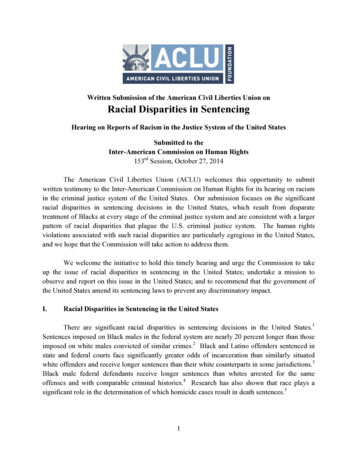
Transcription
National Park ServiceU.S. Department of the InteriorNational Historic Landmarks ProgramCivil Rights in America:Racial Desegregation ofPublic AccommodationsA National Historic Landmarks Theme Study
Cover Photograph: People waiting for a bus at the Greyhound bus terminal, Memphis, Tennessee,September 1943. Library of Congress, Prints & Photographs Division, FSA/OWI Collection[reproduction number: LC-USW3-37974-E].
CIVIL RIGHTS IN AMERICA:RACIAL DESEGREGATION OF PUBLIC ACCOMMODATIONSA National Historic Landmarks Theme StudyPrepared by:Susan Cianci Salvatore, Project Manager & Preservation Planner,National Conference of State Historic Preservation Officers ConsultantEssays prepared by the Organization of American Historians:Matt Garcia, HistorianAlton Hornsby, Jr., HistorianSteven Lawson, HistorianTheresa Mah, HistorianProduced by:The National Historic Landmarks ProgramCultural ResourcesNational Park ServiceU.S. Department of the InteriorWashington, D.C.2004, Revised 2009
CONTENTSINTRODUCTION. 1HISTORIC CONTEXTSAfrican AmericanPart One, 1775-1900 . 5Part Two, 1900-1941 . 21Part Three, 1941-1954 . 32Part Four, 1954-1964 . 43Hispanic . 84Asian American . 109NATIONAL HISTORIC LANDMARKS REGISTRATION GUIDELINES . 119METHODOLOGY . 126SURVEY RESULTSProperties Recognized as Nationally Significant . 128National Historic Landmarks Study List . 130Properties Removed from Further Study . 134Table 1. Properties Recognized as Nationally Significant . 139Table 2. National Historic Landmarks Study List . 140Table 3. Properties Removed from Further Study . 141Areas for Further Research . 143BIBLIOGRAPHYAfrican American, Pre World War II. 144African American, Post World War II . 147Hispanic . 154Asian American . 157General . 159APPENDICESA. Chronological List of Selected Local/National Movements . 160B. Chronology of the May 1961 Freedom Ride: Alabama & Mississippi . 164C. Civil Rights Acts, Interstate Commerce Commission Rulings, & U.S. Supreme Court Rulings . 166
Introduction1INTRODUCTIONMarian Anderson performing at the Lincoln Memorial, Washington, D.C. on April 9, 1939. Marian AndersonCollection, Rare Book & Manuscript Library, University of Pennsylvania.
Introduction2INTRODUCTIONIn 1999 the U.S. Congress directed the National Park Service to conduct a multi-state study ofcivil rights sites to determine the national significance of the sites and the appropriateness ofincluding them in the National Park System. To determine how best to proceed, the NationalPark Service partnered with the Organization of American Historians to develop an overview ofcivil rights history entitled, Civil Rights in America: A Framework for Identifying SignificantSites (2002, rev. 2008). The framework concluded that while a number of civil rights sites hadbeen designated as National Historic Landmarks, other sites needed to be identified andevaluated. Taking this into account, the framework recommended that a National HistoricLandmarks theme study be prepared to identify sites that may be nationally significant, and thatthe study be based on provisions of the 1960s civil rights acts. These include the Civil RightsAct of 1964 (covering voting rights, equal employment, public accommodations, and schooldesegregation enforcement), the Voting Rights Act of 1965, and the Fair Housing Act of 1968.This specific portion of the study focuses on the aspect of public accommodations.1Inclusion in the National Park System first requires that properties meet the National HistoricLandmark criteria, and then meet additional tests of suitability and feasibility. To establishguidance on meeting landmark criteria, this study provides a historic context within whichproperties may be evaluated for their significance in civil rights and establishes registrationguidelines for National Historic Landmark consideration. Completion of this study will alsoassist in the identification of sites for National Historic Landmark evaluation.Public Accommodations OverviewThe physical separation of the races in public accommodations was a resented and demeaningpractice for those denied equal access. Segregation in theaters, restaurants, hotels, and buses wasa constant irritant in everyday life and an insulting inconvenience. It resulted in directconfrontations between racial minorities claiming the right to pay for goods and services in themarketplace, and white business owners who claimed the right to serve whom they chose.Overall, the civil rights movement forced federal intervention that destroyed the legalfoundations of racism and transformed race relations in the nation, particularly the South. Theresulting 1964 Civil Rights Act “was a landmark in legislative attempts to improve the quality oflife for African Americans and other minority groups.” Title II of the act “[o]utlaweddiscrimination in hotels, motels, restaurants, theaters, and all other public accommodationsengaged in interstate commerce.”2A thorough study of desegregation of public accommodations requires an initial understanding ofhow racial segregation has operated in the United States. Segregation did not occur uniformlythroughout the United States, and the form and content of this practice changed over time.Variations in this practice had much to do with the places in which they occurred and the groupsinvolved. This study’s emphasis on “racial” segregation and desegregation suggests, however,1In the area of school desegregation, the National Park Service partnered with the Organization of AmericanHistorians to complete a National Historic Landmarks Theme Study entitled, “Racial Desegregation in PublicEducation in the United States” (2000). Other topics to be covered in future chapters of the civil rights story includehousing, equal employment, and voting.2Quoted material from “Major Features of the Civil Rights Act of 1964,” at http://www.congresslink.org/print basics histmats civilrights64text.htm, The Dirksen Congressional Center, maintained by CongressLink,accessed March 23, 2009.
Introduction3that the denial of equal access to public accommodations to a group or groups had much to dowith the common experience of being labeled nonwhite, and therefore not worthy of equal accesson racial grounds. What made each group nonwhite differed from place to place, but the factthat these beliefs applied to various groups in different locations throughout the nation overmany years is a testament to the ways in which race has shaped our society. State laws, localordinances, and customs that segregated whites and blacks were also applied to other minorities.To represent this aspect, this study expands beyond the African American story to include theHispanic and Asian American stories.Of special note in documenting the Hispanic experience in discrimination is the level ofdocumentation available in the area of public accommodation segregation and desegregation ascompared to other areas of discrimination. The most documented cases of systematicsegregation and desegregation have occurred in the realm of education because public schoolswere the sites of the most organized attempts to separate groups along racial lines. The fight todismantle school segregation involved numerous court cases such as Mendez v. Westminster(1946) and Brown v. Board of Education of Topeka (1954) that produced richly documentedsources for historians to piece together.3 Similarly, historians of segregation and desegregationin housing have benefited from rich archival sources such as restrictive clauses in new housingcontracts and the records of the Federal Housing Administration. Court cases such as Shelley v.Kraemer (1948) figured prominently in the struggle to end the practice of residential segregationthat left behind valuable evidence of desegregation.4 The systematic and legal nature of botheducational and housing discrimination has made the writing of this history possible.In documenting Hispanic experiences of segregation in public accommodations, many historianshave relied on oral history and material evidence (such as photos of signs reading “White-tradeOnly” on places of business) as well as court cases and legislative acts to compile a record of thissegregation. Struggles against such systems of discrimination have largely been documented inSpanish and bilingual community newspapers that reported mass movements against theaters,public pools, restaurants, and bars that denied equal service to Hispanic clientele. While thesehistories provide a fuller picture of the kind of racial exclusion experienced by Hispanic people,they have not been addressed in books and articles focused solely on segregation in publicaccommodations. Rather, these experiences have been embedded in more general discussions ofdiscrimination and the civil rights movement. Unlike education and housing desegregation thatemerged as a result of landmark court decisions, the end of segregation in publicaccommodations more often occurred in the wake of direct action such as picketing, boycotts,and media attention to the problem.53In the case of Mendez v. Westminster School District, 64 F. Supp. 544 (1946), 161 F. 2d 744 (1947), the courtsfound segregation of Mexican students unlawful in California and a denial of the equal protection clause of theFourteenth Amendment. In Brown v. Board of Education, 347 U.S. 483 (1954), the U.S. Supreme Court foundpublic school segregation unconstitutional.4Matt Garcia, A World of Its Own: Race, Labor, and Citrus in the Making of Greater Los Angeles, 1900-1970(Chapel Hill: The University of North Carolina Press, 2001), 24; George Lipsitz, The Possessive Investment inWhiteness: How White People Profit from Identity Politics (Philadelphia: Temple University Press, 1998), 25-33;Carey McWilliams, “Los Angeles: An Emerging Pattern,” Common Ground 9 (spring 1949): 3-10. Shelley v.Kramer, 334 U.S. 1 (1948) found racially restrictive covenants in real estate illegal.5The public accommodations overview for the Hispanic experience is excerpted from Matt Garcia’sHispanic context provided for this study.
Introduction4The National Park Service also gave consideration to including the American Indian experiencein this study. For American Indians (including Alaska Natives and Native Hawaiians), the CivilRights in America: A Framework for Identifying Significant Sites did not identify any events,persons, or places associated with access to public accommodations. It did, however, recognizethat the American Indian civil rights story is unique. Therefore, the framework recommendedthat, subject to available funding, a civil rights study related to American Indians be undertaken.Study FormatThis document begins with a historic context on the segregation and desegregation of publicaccommodations that includes both places of business and public transportation. The firstsection on African Americans is divided into four chronological periods. Part One covers thecolonial era and extends up to the age of Jim Crow. Part Two covers the age of Jim Crow toWorld War II. Part Three begins with the effects of World War II on discrimination andexplores the various efforts for desegregation in the post war period up to 1954 and the U.S.Supreme Court’s decision in Brown v. Board of Education. Part Four is devoted to the moderncivil rights movement leading up to the passage of the Civil Rights Act of 1964. Subsequentessays explore the Hispanic and Asian American experiences of the nineteenth and twentiethcenturies.Registration guidelines then outline how properties may qualify for National Historic Landmarkdesignation. The summary of identification and evaluation methods describes the methodologyused in the survey, and lists currently designated and potential historic properties identifiedduring the course of the study. A series of appendices conclude the study. Appendix A containsa chronological list of selected local and national movements. Appendix B describes thechronological development of the May 1961 Freedom Ride through Alabama and Mississippi.Lastly, Appendix C lists civil rights acts, Interstate Commerce Commission rulings, and U.S.Supreme Court rulings associated with racial discrimination in public accommodations.
African American – Part One, 1775-1900AFRICAN AMERICANPART ONE, 1775-1900Newspaper illustration from the London News, September 27, 1856. African-American Perspectives: TheProgress of a People, Library of Congress.5
African American – Part One, 1775-19006COLONIAL ERA TO THE CIVIL WAR6Colonial Free Black PopulationThe issue of equal access to public accommodations arose early in the history of the UnitedStates of America. It began in the colonial era and continued through the Civil War into thetwentieth century. Since most persons of African descent in the North American colonies, andlater the United States, were in bondage prior to the Civil War, the question of race and publicaccommodations was largely one which affected the class of blacks known as “free Negroes.”The origins of this class were characterized by similar factors. Standing out foremost areemancipation or manumission by slave owners, purchase by free blacks or others, escape fromslavery, and state action. Between 1775 and 1783, emancipation accelerated in some placesduring the “atmosphere of freedom” created by the American Revolution.It is impossible to render an accurate estimate of this free black population before the first censusof 1790. Even with the first and later censuses, the enumeration of this population was fraughtwith difficulties and obstacles. One difficulty was that much of the black population became“invisible” at census-taking time, as many blacks tended to fear census takers as “slavecatchers.” Another difficulty was how black residences, located in dilapidated and dangerousparts of cities or isolated parts of rural areas, deterred census takers. Lastly, categories ofAfrican Americans based upon skin complexion or circumstance of birth complicated specificracial designation.7Beginning in the nineteenth century, growth in the free black population is attributed to theabolition of slavery in the North, the increase of manumissions in the Upper South, and thegrowing possibility for slaves to either purchase their freedom or run away in the South. By1830, slavery in the North had been virtually abolished through constitutional, judicial, orlegislative action and the free black population had increased substantially from 27,000 in 1790,to about 130,000 in 1830. In the Upper South the free black population rose from 30,000 in1790, to about 150,000 in 1830. However, the story in the Lower South was quite different. In1790 there were only about 2,000 free blacks. Even with adding Louisiana after 1803, the freeblack population in the Lower South was no higher than in the Upper South in 1790.8As this population grew, legal restrictions on their political and civil rights (especially in thecities) were quickly enacted and reflected the steady deterioration of the legal and social status offree blacks, making it difficult to distinguish between slaves and free blacks.9 Also, fear of slaveinsurrections, such as Nat Turner’s rebellion in 1831, had the effect of deterring further slavemanumission and constricting the liberty of free blacks in the South. Some scholars haveproduced valuable studies on the effect of racism on the free black caste. Historian WinthropJordan observed that colonists denounced people they felt could potentially incite slave6Part One of this study on African American history was authored by Alton Hornsby, Jr., Fuller E. CallawayProfessor, Morehouse College, and Susan C. Salvatore, preservation planner, National Park Service, NationalHistoric Landmarks Program.7Ira Berlin, Slaves Without Masters: The Free Negro in the Antebellum South (New York: Pantheon Books, 1974),15; Donald R. Wright, African Americans in the Early Republic, 1789-1831 (Arlington Heights, Ill.: HarlanDavidson, Inc., 1993), 126; Alton Hornsby, Jr., Chronology of African American History, 2nd ed. (Detroit: GaleResearch, Inc., 1997), xx.8Berlin, Slaves Without Masters, 46-49; Leon F. Litwack, North of Slavery: The Free Negro in the United States,1790-1860 (Chicago: The University of Chicago Press, 1961), 14.9Hornsby, Chronology of African American History, xx-xxi.
African American – Part One, 1775-19007insurrections. Chief among those suspected were free Negroes who would side with those oftheir color rather than those of their legal status, and thus became feared and despised for theirthreat to white society. Historian Leon Litwack noted that the rights of citizenship were withheldfrom free Negroes and that until after the Civil War “most northern whites would maintain acareful distinction between granting Negroes legal protection—a theoretical right to life, liberty,and property—and political and social equality.” Even the social standing between freed whiteindentured servants and freed slaves differed. Lorenzo Greene, one of the first African Americanscholars to present a comprehensive study of New England blacks, observed that freed servantsbecame respected members of the community, while freed slaves remained in a lower socialstatus even if they had taken on their former masters’ culture.10Antebellum Exclusion & SegregationThe northern colonies primarily tended to address issues of the right to public accommodationsthrough local ordinances and customs. Up to the Civil War, the colonies, and later states, mostoften “reserved” public accommodations for whites only. Litwack summarizes the separatetreatment of African Americans thusly:They were either excluded from railway cars, omnibuses, stagecoaches, andsteamboats or assigned to special “Jim Crow” sections; they sat, when permitted,in secluded and remote corners of theaters and lecture halls; they could not entermost hotels, restaurants, and resorts, except as servants; they prayed in “Negropews” in the white churches. . . . Moreover, they were often educated insegregated schools, punished in segregated prisons, nursed in segregatedhospitals, and buried in segregated cemeteries.11In 1804, Ohio took the lead in passing Black Laws that were designed to restrict the rights andfreedom of movement of free blacks in the North that served as early precursors to “Jim Crow”ordinances and legislation. Blacks were barred from the militia and medical infirmaries, andeven though they paid equal taxes on their property, their children were excluded from publicschools.12In Massachusetts, blacks sought an end to the state’s Jim Crow transportation practices. Whenthe Boston and Providence Railroad opened its route to New York, the company’s presidentstated that “an appreciable number of the despised race demanded transportation. Scenes of riotand violence took place, and in the then existing state of opinion, it seemed to me that the10Winthrop D. Jordan, White Over Black: American Attitudes Toward the Negro, 1550-1812 (New York: W. W.Norton, 1977), 122-123; Litwack, North of Slavery, 15; Lorenzo Greene, The Negro in Colonial America (NewYork: Columbia University Press, 1942), 299, 332.11Litwack, North of Slavery, 97. The term “Jim Crow” originated in 1832 as the name of a character in a song anddance written by Thomas D. Rice, a well-known minstrel of the time. Minstrel shows were popular before the CivilWar and featured white performers in black face portraying “musical, lazy, childlike blacks.” Eric Foner, ed.,America’s Black Past: A Reader in Afro-American History (New York: Harper and Row Publishers, 1970), 142. Inregard to segregation, the term “Jim Crow” first came into use prior to the Civil War. In the 1830s, “Jim CrowCars” referred to segregated cars on some northern railroad lines. Otherwise the system of Jim Crow segregationapplies to the post-Reconstruction era beginning in 1877 when southern states took legal action to separate the racesin public spaces.12William Cheek and Aime Lee Cheek, John Mercer Langston and the Fight for Black Freedom, 1829-1865(Urbana: University of Illinois Press, 1996), 49, 135.
African American – Part One, 1775-19008difficulty could best be met by assigning a special car to our colored citizens.”13 Massachusettsnewspapers in 1838 reported frequent incidents of Negroes refusing to sit in Jim Crow sectionsand being forcibly removed from the train. Negroes also sought relief through the legislature andwhite abolitionists encouraged boycotts. As a result, a joint legislative committee recommendeda bill to halt discrimination. Negative reaction followed. Fearing increased integration, one statesenator declared that “such legislation would not stop at forcing the mixture of Negroes andwhites in railroad cars, but would subsequently be applied to hotels, religious societies, andthrough all ramifications of society.” The act failed to pass.14By 1841, intense efforts to end Jim Crow cars began. Black abolitionists like FrederickDouglass refused to move to the Jim Crow car and did so only after being physically removedfrom their seats.15 In 1842, the black abolitionist Charles Lenox Redmond went before acommittee in the Massachusetts legislature to protest his segregation in a “special railway car fornegroes.” Touching upon the right to equality and inherent inferiority without it, Redmondstated that “the wrongs inflicted and injuries received on railroads by person of color . . . do notend with the termination of the route, but in effect, tend to discourage, disparage, and depressthis class of citizens.”16Protests, changing public opinion, and threats of legislative action caused rail companies inMassachusetts to abandon segregation practices in 1843. Elsewhere in the North, by 1865,abolitionists and blacks used petitions, legislative lobbying, boycotts, and law suits to thwartnorthern segregated transportation. Although the practice continued on a limited basis, JimCrow travel ceased as a major problem for northern blacks.17For southern blacks, segregation was not always legally or rigidly enforced. However, Negroesgenerally could not enter hotels and restaurants, and in some locations faced discrimination inpublic conveyances. Overall, they were separated from whites in public buildings ifaccommodated at all. In Charleston, Richmond, and Savannah, blacks could enter publicgrounds and gardens only during certain hours or were restricted all together. At times separateinstitution building for blacks occurred (albeit for the economic advantage of white businessowners). One such example was an “exclusive resort for free people of color” on Louisiana’sLake Pontchatrain. Opened by a New Orleans railroad in the 1830s, the railroad instituted“blacks only” cars to transport their patrons.18A major opportunity for judicial interpretation of segregation presented itself when abolitionistsand others brought a suit on behalf of a bondsman, Dred Scott. Between 1834 and 1838, Scott’sowners had taken him into the free territories of Illinois, Minnesota, and Wisconsin. Scott suedfor his freedom contending that he should be a free man under the provisions of the MissouriCompromise of 1820. In 1857, the U.S. Supreme Court ruled in Scott v. Sandford that Scott was13Litwack, North of Slavery, 106-107.Ibid., 103-104, 108; Darlene Clark Hine, William C. Hine and Stanley Harrold, The African-American Odyssey,2nd ed. (Upper Saddle River, N.J.: Pearson Education, Inc., 2002), 153, 316.15August Meier and Elliott Rudwick, Along the Color Line: Explorations in the Black Experience (Urbana:University of Illinois Press, 1976), 308-309.16Mortimer J. Adler, Charles Van Doren, and George Ducas, eds., The Negro in American History (Chicago:Encyclopaedia Britannica Educational Corp., 1969), III:146-150. Quotation on 147.17Catherine Barnes, Journey from Jim Crow: The Desegregation of Southern Transit (New York: ColumbiaUniversity Press, 1983), 2.18C. Vann Woodward, The Strange Career of Jim Crow (New York: Oxford University Press, Inc., 2002), 13-14;Berlin, Slaves Without Masters, 322-323.14
African American – Part One, 1775-19009not and could not be a citizen of Missouri “within the meaning of the Constitution of the UnitedStates” and thus could not sue in its courts. Furthermore, the Court held that Congress had noauthority to forbid slavery in the territories.19Quasi-free blacks and their white allies reacted quickly and angrily to the Court’s decision,which placed their already fragile rights in further jeopardy. Indeed, the Scott decision seemedto firmly institutionalize the inferior status of all blacks and to place them only at the sufferanceof whites. While most vowed to do what they could “by all proper means,” greater despairovercame many; others plotted rebellion with their white allies. But plots and rebellions, eventhe sensational one by white abolitionist John Brown at Harpers Ferry, Virginia in 1859, were nomatch for a Slavocracy (an economic and political system in which slavery is the organizingprinciple) that was fully supported by the United States government. The inability of many inthe North and West to accept the possibility of a nation dominated by Slavocracy proved to bethe catalyst that would soon reopen the doors of “freedom” to quasi-free blacks and lead to theemancipation of African American bondspeople. The conflict between slave states and freestates soon tore the nation asunder.RECONSTRUCTION’S BLACK CODES TO THE AGE OF JIM CROWThe Civil War brought major alterations in almost every aspect of American life. Foremostamong these were the destruction of American Negro slavery and the granting of citizenshiprights to freed and free blacks. Lincoln issued the Emancipation Proclamation on January 1,1863, and he spoke of freedom and justice in the Gettysburg Address of 1863. After hisassassination, blacks and fellow Republicans mourned “the Great Emancipator,” while the moreardent of the radical Republicans took heart in the ascension of his successor, the maverickdemocrat Andrew Johnson of Tennessee. Johnson proved disheartening to black civil rightsadvances as southern provisional legislatures, established under Johnson’s presidency, adoptedBlack Codes to limit Negro civil rights. From 1865 to 1867, blacks were restricted from insaneasylums, orphanages, poorhouses, institutions for the deaf and dumb, and either prohibited fromfirst class rail cars or required segregated cars.20To enforce the end of slavery and ensure equal rights for freed blacks, the Republican Congressproposed the Civil Rights Act of 1866. The act declared that all persons born in the UnitedStates (except Indians) were citizens regardless of race, color, or previous condition of slavery orinvoluntary servitude. Under the act, blacks received rights they could enjoy as equally aswhites, such as the ability to make and enforce contracts and to purchase and hold property.21But, on March 27, 1866, President Andrew Johnson vetoed the landmark legislation on thegrounds that it violated states’ rights. The Republican Congress was able to override Johnson’sveto. Continuing southern resistance prompted Congress to further action when, in March 1867,it approved the first Military Reconstruction Act halting Johnson’s reign over Reconstruction.19Stanley I. Kutler, The Dred Scott Decision: Law or Politics (Boston: Houghton Mifflin Co., 1967), xvi-xix, 8-9;John R. Howard, The Shifting Wind: The Supreme Court and Civil Rights from Reconstruction to Brown (Albany:State University of New York Press, 1999), 12, 19. Scott v.
U.S. Department of the Interior National Historic Landmarks Program Civil Rights in America: Racial Desegregation of Public Accommodations A National Historic Landmarks Theme Study. Cover Photograph: People waiting for a bus at the Greyhound bus terminal, Memphis, Tennessee,
